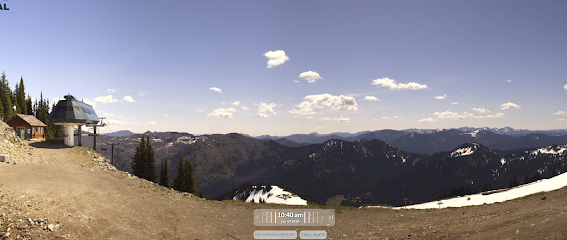As I will demonstrate below, this past week has been unusually cool around the region.
But that leads to another question....is mid-June getting warmer or colder?
A strange question when there is so much talk about global warming. But as you will learn below, the truth will be stranger still 😀
Let's start is an image this morning at the Paradise Visitor Center on Mount Rainier (about 5000 ft up). They had a mixture of rain and snow showers with fog. Yuck. Not my choice for hiking!
Next, consider the differences in daily average local temperatures from normal for the past week (below). Green, blue, and purple colors are below normal.
No wonder I have been wearing my sweatshirts! Most of Washington State has been cooler than normal and much of western Washington has been 3-5F below normal. My tomato plants have been struggling for a reason.
But you didn't need me to tell you it has been cool and drippy.
But now something interesting: is mid-June getting cooler or warmer in our region?
Below I have plotted the trends of temperatures for the past week (June 9-16th) at Hoquiam, on the central WA coast. This was the FIFTH COOLEST mid-June since 1953 (roughly 70 years!) And there is little long-term trend (brown line)
At Olympia, there was not only a colder than-normal mid-June, but mid-June is getting COOLER over time.
At Bellingham, mid-June temps this year were in the top-ten cold years, and there is no trend up or down in mid-June temperatures.
I am not showing SeaTac Airport because the site is useless for any climatological work with the addition of a third runway, greatly increased aircraft operations, and a large amount of development around the airport.
What about Wenatchee in eastern Washington, located in prime tree-fruit country? (see below)
OMG! Not only was this a cold mid-June, but the long-term trend is for cooling.
Can this REALLY be true? Consider Yakima, also in prime agricultural land. There is NO trend in temperatures in mid-June.
A similar lack of mid-June temperature trend is also true in Spokane.
So how can this be? With all the global warming talk, how could our mid-June temperatures be unchanging or cooling?
The key reason is our location near the cool Pacific Ocean. During mid-June, we still have a vigorous onshore flow of cool ocean air that isolates much of our region from the warming of the interior.
In fact, enhanced warming of the interior can cause pressure to fall more there, which creates MORE of an onshore pressure difference (high offshore and low pressure over the interior).
We have global warming protection this time of year!
Such climate subtleties are important but unfortunately missing in most media coverage.
______________________________________
Notice
A Steve Pool memorial undergraduate scholarship has been established in his honor (see below)
Once funded by contributions, this new undergraduate scholarship will provide financial assistance to promising Atmospheric Sciences students, fostering the training of the next generation of meteorologists and atmospheric scientists.
If you want to contribute or learn more about Steve, check out the webpage below. Thanks so much....cliff


















































